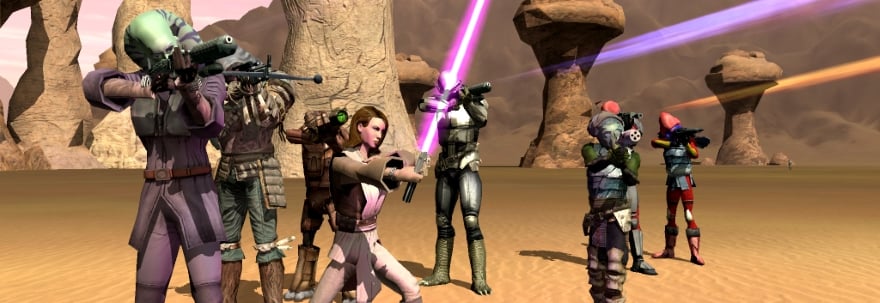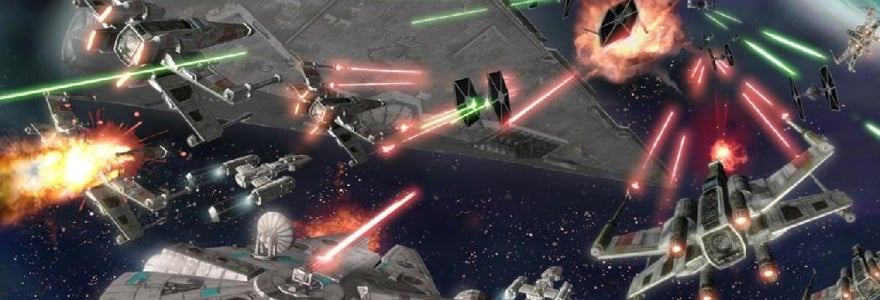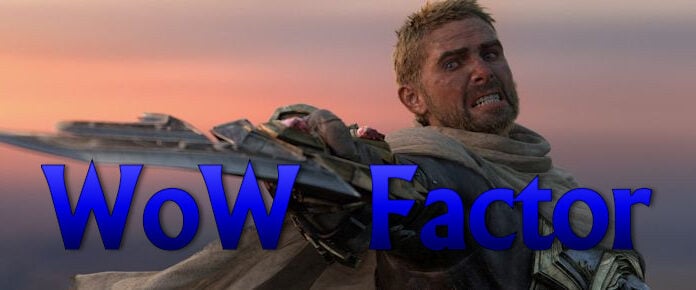
It became one of the most infamous moments in MMO history — and perhaps one of the most misunderstood.
For all that the MMO community references Star Wars Galaxies’ New Game Enhancements (NGE) as a synonym for devs breaking a game with a horrible patch, expansion, or business decision, the actual details of the referenced events have become blurred through time, retellings, and a sort of weird mythology.
It’s been 10 years since the NGE damaged a game’s reputation, embittered players for life, and made the mainstream notice that not all was sunshine and daisies in MMOs. So how did this disaster occur and what was so bad about it?
Well, it happened a long time ago in a studio far, far away…
 Disturbances in the Force
Disturbances in the Force
To discuss the NGE, one needs to understand the context of the situation, and for pioneering players, the halcyon days of the early SWG era were sometimes anything but. As visionary and creative a product as Star Wars Galaxies was (just ask any veteran to tell you what he or she loved about the game), both players and developers alike wouldn’t argue with any accusations that the title was rushed out the door too soon, buggy beyond belief, and starving for content. Even so, players developed a real fondness for what was there.
“When the game launched, it didn’t actually work,” Raph Koster later wrote. “Like, you couldn’t log in.”
As a half-finished game, Star Wars Galaxies struggled to fulfill its destiny by patching in content, fixing bugs, and expanding to include space combat. Even with the rough ride, SWG rose to around 300,000 subscribers early on, a highly respectable number for the time, but not quite what both SOE and LucasArts had anticipated with the Star Wars label. To make matters worse, the rise of World of Warcraft and its multi-million subscriber count gave the suits a serious case of Blizzard envy.
Controversy seemed to dog Star Wars Galaxies as a fact of life. The “Jedi problem” stirred up problems, both when players were struggling to figure out how to unlock this secret class and after when players had to grind their tails off to use the force. There was also a nasty nerf to group XP in August 2004 that caused a sizable exodus from the population. Designer Raph Koster noted, “This single event doubled the churn rate of the game, and even after it was all put back, it stayed 50% higher than it had been ever after. In fact, it was worse, in percentage terms, than the NGE was.”
The Combat Upgrade (CU) and Trials of Obi-Wan
As SWG headed into its second year of operation, SOE was looking for ways to improve what it saw as a flawed but promising product. Jump to Lightspeed had been a well-received expansion, with plenty of twitch combat that kept the action fun and frantic. Meanwhile, the ground combat experience was suffering, and the dev team prepared a combat upgrade (CU) for late April 2005 to rectify the core issues.
While the CU theoretically made combat faster and addressed some of the problems, the execution of the patch was a minor disaster. Players grumbled about SWG’s slow performance, some professions were adversely affected, and a new batch of bugs sprung up. “Instead of finally providing the player base with a polished game, the CU kept gameplay feeling as if the game was still in beta test,” blogger The Lady Gamer said.
However, then-SOE President John Smedley defended the update: “The Combat Upgrade was [crucial] for the long-term health of the game. In order to make the experience in SWG more diverse and to breathe new life into this game, we felt it was important for us to entirely overhaul the current system and to make sure that it’s balanced properly.”
This quote would prove telling, as SOE had been in deep discussions within both the studio and LucasArts to jazz up SWG’s gameplay and provide a more “Star Warsy” feel to the title.
Gordon Walton recently shared some insider perspective from these talks, arguing that he was at least partially to blame for the NGE. Walton said that the team had been experimenting with a spin-off SWG game that involved twitch combat and planetary conquest, a concept that was rolled into the NGE. “I participated in the early planning for the NGE, and I was told to execute it over my and many others on the SWG teams’ objections,” he said. “I failed as an effective communicator in my attempts to change this course.”
Raph Koster has gone on record as saying that all of the developers and execs involved with these discussions simply wanted the best for Star Wars Galaxies and that they shouldn’t be demonized: “I think everyone had good intentions in trying to make the game more Star Warsy for that audience. They wanted to make the game more fun. This includes the Holocron drops, and the NGE, and CU too.”
SWG’s third expansion, Trials of Obi-Wan, was announced in August 2005, giving fans something to anticipate. Included in the expansion features were promised updates to many suffering professions. Players pre-ordered the expansion and gradually got over sore feelings from the CU.
 Thermal Detonation
Thermal Detonation
On November 1st, 2005, Trials of Obi-Wan launched with the new planet of Mustafar.
A day or so later, as players were getting settled in to the expansion content, SOE dropped a game-changing bombshell. In two weeks, the studio announced, it would be implementing “New Game Enhancements” to streamline the game’s professions and make combat twitch-based. The NGE would be a top-to-bottom revamp of much of SWG two years into the live game and negate many of the profession changes that the expansion 24 hours earlier included.
Producer Julio Torres defended the timing of the announcement by saying, “There were several other announcements related to the Star Wars franchise going on at the time, so we wanted to make sure that something this big didn’t get lost in the shuffle.”
“Enhancements to a live game are never easy to introduce or implement,” SOE posted in the NGE FAQ. “We have received feedback over the years through research, focus groups, community forums and anecdotal encounters that our game was very complex — many people never made it past the early levels. For that reason, we embarked on this significant redesign of our beginning game to make it more fun and more of a true Star Wars adventure. Once those changes were completed the results were so startlingly positive, in terms of the game play experience that we wanted to bring this level of fun to the rest of the game.”
Publish 25 went live on November 15th, forever separating Star Wars Galaxies into two eras: pre-NGE and post-NGE. Players logged in to find that the professions had been condensed into nine classes, combat had been changed to adapt a twitch-based first-person shooter style, and WoW-like levels had supplanted the old character system. Some of the old professions, like Creature Handler, had simply vanished with no new class substitute to take their place.
To rub salt into the wounds of mourning players, the NGE caused all sorts of new performance and gameplay issues, much like what happened with launch and the CU. Some players even complained of motion sickness from the new style of combat.
“In essence, the NGE removed the ‘virtual world’ portion of the game,” blog Terra Nova bemoaned, “the one continuing virtue that the old design still had, the one asset or accomplishment of SWG that drew what was left of its player base.”
 Fallout
Fallout
The community was stirred up something fierce, and SOE hit the press circuit to do damage control. On November 16th, Smedley apologized for the timing of the NGE announcement but not the patch itself. “We feel very, very strongly that our current players are going to enjoy the enhancements to the game,” he said in a Q&A session. “The content in Trials of Obi-Wan is even more fun with the new game experience.” Smedley went on to explain that it was too difficult for the team to try to balance the 34 professions and that nine would be much more managable.
Torres went on G4TV and delivered a tone-deaf interview in which he brushed aside serious concerns by players and the disastrous implementation of the patch. “A lot of [players] come back after they feel like, OK, they’ve vented their concerns,” he predicted. In another interview, Torres claimed that SOE did not mean to mislead players but would continue to make changes as the studio saw fit: “We will continue to improve the game in areas wherever it is deemed needed to make the game fun and enjoyable for all players.”
Senior Director Nancy MacIntyre threw more fuel on the fire by apparently throwing SWG’s sandbox nature under the bus: “There was lots of reading, much too much, in the game. There was a lot of wandering around learning about different abilities. We really needed to give people the experience of being Han Solo or Luke Skywalker rather than being Uncle Owen, the moisture farmer. We wanted more instant gratification: kill, get treasure, repeat. We needed to give people more of an opportunity to be a part of what they have seen in the movies rather than something they had created themselves.”
If Torres, Smedley, and MacIntyre thought that the NGE would blow over, they were wrong. The outcry from from the community was so great that it caught the attention of several mainstream press outlets such as the New York Times and the Washington Post, which gave affected players a stage to share how the NGE impacted them. “We just feel violated,” player Carolyn Hocke told the Times.
“The customer losses were significant, and the blow to both the SWG and SOE brands was noticeable,” developer Gordon Walton said. Subscriber numbers fell from 250,000 to just above 100,000 by mid-2006, and while refunds for the Trials of Obi-Wan expansion were eventually given to those who asked, paid game time was not reimbursed.
As if this wasn’t enough of a PR nightmare, one member of SWG’s team took a vocal stance against the NGE. Community Manager Diane “Tiggs” Migliaccio posted an epic rant against the patch on the forums, saying, “Thinking about all of this it seems to me that in SOE’s rush to get product to market in the first place they dropped the ball bad, and instead of making things better, they constantly seem to make the wrong decisions. Stop f’ing around with focus groups, and fire the marketing suits and hire some good, competent developers and people with vision.”
Migliaccio was subsequently fired and escorted from the building. “Her abrupt departure made her a martyr among a playerbase whose already high hostility had just been turned up to 11,” blogger That Chip Guy noted. “Forum moderators from other SOE games had to be called in to help manage the message boards.”
Recovery
Eventually SOE went from defending the patch to repeatedly apologizing for it. In 2007, Smedley issued a clear mea culpa: “With the NGE, I’m sorry about the mistake we made. We screwed up and didn’t listen to the fans when we should have, and it’s not a mistake we’re going to make again.”
The anger and distrust of SOE had sunk in so deep that such words couldn’t pacify some players. Even developers were targets years later. Designer Dan Rubenfield wrote a post in 2008 admitting that the NGE was “a huge mistake” but still defending parts of it. His drubbing by the community showed that not all was forgiven. Linda Carlson said that even in 2013 — two years after SWG had shut down — SOE was still taking hate mail for the patch.
“It was a stunning lesson in how not to do things,” said Linda Carlson. “It was too much change. It was brought in all at once. Even after the event there was an idea that it would blow over, but it didn’t. There was so much anger. You cannot hide from these events.”
The NGE wasn’t the end for Star Wars Galaxies, of course. While the game did take a subscriber hit, gradual improvements and perseverance helped to marry some of the best of the old features with the new ones introduced with the NGE. The game actually got good and cultivated a strong community until its premature demise in 2011.
“If it was a failure or a success, it was a glorious, ramshackle, bumbling stumbling mess of one,” Koster wrote this year. While the NGE was an unqualified failure, SWG proved to be robust enough to weather it in the long run.
 Believe it or not, MMOs did exist prior to World of Warcraft! Every two weeks, The Game Archaeologist looks back at classic online games and their history to learn a thing or two about where the industry came from… and where it might be heading.
Believe it or not, MMOs did exist prior to World of Warcraft! Every two weeks, The Game Archaeologist looks back at classic online games and their history to learn a thing or two about where the industry came from… and where it might be heading.













